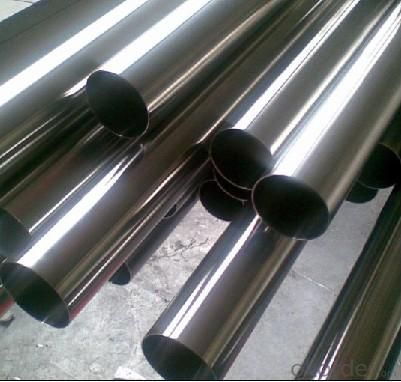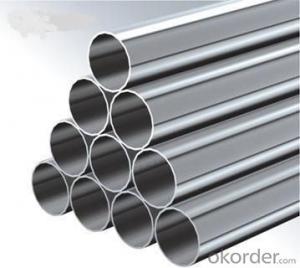304 stainless steel welded polished pipe
- Loading Port:
- Shanghai
- Payment Terms:
- TT OR LC
- Min Order Qty:
- 50 m.t.
- Supply Capability:
- 3000 m.t./month
OKorder Service Pledge
OKorder Financial Service
You Might Also Like
Item specifice
304 stainless steel welded polished pipe
Some details of our products
Product: stainless steel pipe
Grade:304;316
Standard:ASTM,AISI,JIS,EN,DIN,GB
Surface treatment:8k, ba
Thickness:1.0-60mm
Outer Diameter6-630mm
Productivity:800MT/Month
Products range Industrial tube, decorative tubeProcessing: Stainless steel pipe
There are high-tech equipments to processing stainless coils and sheets/plates with skilled workers.
Cut to length
Decoiling and slitting
Grinding and brushing
Film protection
Plasma and water jet cutting
Folding and embossingProduct show

5.RFQ
1.small quantity, short time delivery
If we have stocks, the delivery time is less than 7 days,If the quantity is more than 500Tons,the delivery time is abou 30 days after confirming the order.
2.Choose the appropriate metals stainless steel for your needs.
We carefully balance quality, delivery time and price,procure various grades metals from all over the world.
3.Lower total cost
We taking your processing into account,offer you reduce a total cost by using our product.
We assure you:
Small MOQ + Cheap Price + Fantastic Quality + Fast Delivery
- Q:Are stainless steel pipes resistant to chemical corrosion?
- Yes, stainless steel pipes are resistant to chemical corrosion. This is due to the high levels of chromium present in stainless steel, which forms a protective oxide layer on the surface of the pipes. This oxide layer acts as a barrier, preventing chemical substances from coming into contact with the underlying steel and causing corrosion. Additionally, stainless steel pipes are also resistant to other types of corrosion, such as rusting, making them a popular choice for various industrial, commercial, and residential applications where exposure to chemical substances is expected.
- Q:Are stainless steel pipes fire-resistant?
- Indeed, fire resistance is a characteristic possessed by stainless steel pipes. Renowned for its elevated melting point and exceptional fire resistance, stainless steel is a secure material choice for numerous purposes, including the construction of pipes. With its incapability to readily ignite or facilitate the expansion of flames, stainless steel ensures safety in various applications. Moreover, stainless steel pipes exhibit remarkable durability and strength even when exposed to high temperatures, assuring an additional layer of safety in environments susceptible to fires.
- Q:Can stainless steel pipes be used in the food industry?
- Yes, stainless steel pipes can be used in the food industry. Stainless steel is a highly durable and corrosion-resistant material, making it suitable for various applications in the food processing and handling sector. It is commonly used for transporting liquids, gases, and solids, ensuring the integrity and safety of food products. Stainless steel pipes also maintain the hygiene standards required in the food industry, as they are easy to clean and resistant to bacterial growth.
- Q:Can stainless steel pipes be used for brewery applications?
- Yes, stainless steel pipes can be used for brewery applications. Stainless steel is the preferred material for many breweries due to its excellent corrosion resistance, durability, and hygienic properties. Stainless steel pipes do not react with the ingredients in beer, ensuring the purity and taste of the final product. They are also easy to clean and maintain, reducing the risk of contamination. Additionally, stainless steel pipes can withstand high temperatures and pressures, making them suitable for various brewery processes such as brewing, fermentation, and storage. Overall, stainless steel pipes are a reliable and long-lasting choice for brewery applications.
- Q:How do you calculate the pressure drop in stainless steel pipes?
- In order to determine the pressure drop in stainless steel pipes, one must take into account various factors including the flow rate, pipe diameter, pipe length, and the properties of the fluid being transported. The pressure drop can be calculated using the commonly used Darcy-Weisbach equation, which is as follows: ΔP = (f * (L/D) * (ρ * V^2))/2 Where: ΔP represents the pressure drop (in units of force per unit area, such as psi or Pa) f is the Darcy friction factor (which depends on flow conditions and pipe roughness) L represents the pipe length (in units of length, such as meters or feet) D is the pipe diameter (in units of length, such as meters or feet) ρ corresponds to fluid density (in units of mass per unit volume, such as kg/m^3 or lb/ft^3) V represents fluid velocity (in units of length per unit time, such as m/s or ft/s) To calculate the pressure drop, one must determine the Darcy friction factor, which is dependent on the Reynolds number (Re) and the relative roughness of the pipe. The Reynolds number can be calculated using the following equation: Re = (ρ * V * D)/μ Where: μ represents fluid viscosity (in units of force per unit area per unit time, such as Pa·s or lb/ft·s) Once the Reynolds number has been determined, empirical correlations or Moody's chart can be used to find the Darcy friction factor for the given flow conditions. With the friction factor, pipe length, diameter, fluid density, and velocity, the pressure drop can then be calculated using the Darcy-Weisbach equation. It is important to note that the aforementioned equations provide an approximate calculation of pressure drop in stainless steel pipes. The accuracy of the calculation may be influenced by factors such as pipe roughness, fluid properties, and the flow regime. It is also recommended to consult relevant standards or engineering references for more detailed and accurate calculations.
- Q:What does "stainless steel pipe 201304" mean?
- 201 stainless steel has a certain acid, alkali resistance, high density, polishing, no bubbles, no pinhole and other features, is the production of various watchcase, strap, cover, high-quality materials. Mainly used for decorative pipes, industrial pipes, and some shallow stretch products. The product belongs to high manganese, low nickel stainless steel, nickel content is low, poor corrosion resistance, in all kinds of desktop, countertops, kitchenware, and outdoor decoration projects and urban decoration industry and high-end household products, a larger amount.
- Q:Can stainless steel pipes be used for underground sewer lines?
- Yes, stainless steel pipes can be used for underground sewer lines. Stainless steel is highly resistant to corrosion and is a durable material, making it suitable for underground applications where the pipes may come into contact with moisture, chemicals, and other harsh elements. Additionally, stainless steel pipes have a long lifespan and require minimal maintenance, making them a reliable choice for underground sewer lines.
- Q:What are the different standards and specifications for stainless steel pipes?
- There are several different standards and specifications for stainless steel pipes, which vary based on their intended use and the region in which they are being used. Some of the most common standards and specifications for stainless steel pipes include: 1. ASTM (American Society for Testing and Materials): ASTM A312/A312M is a standard specification for seamless, welded, and heavily cold worked austenitic stainless steel pipes. This specification covers various grades of stainless steel pipes for high-temperature and general corrosive service. 2. ASME (American Society of Mechanical Engineers): ASME B36.19M is a standard specification for stainless steel pipes that covers the dimensions, wall thickness, and tolerances for both welded and seamless pipes. ASME B36.10M is another standard that specifies the dimensions and tolerances for seamless and welded stainless steel pipes. 3. EN (European Norms): EN 10216-5 is an European standard that specifies the technical delivery conditions for stainless steel seamless pipes for pressure purposes. EN 10217-7 is another European standard that covers welded stainless steel tubes for pressure purposes. 4. JIS (Japanese Industrial Standards): JIS G3459 is a standard specification for stainless steel pipes that are used for high-temperature service. JIS G3468 specifies the stainless steel pipes for general service. 5. DIN (Deutsches Institut für Normung): DIN EN 10216-5 is a German standard that specifies the technical delivery conditions for stainless steel seamless pipes for pressure purposes. DIN EN 10217-7 is another German standard that covers welded stainless steel tubes for pressure purposes. These are just a few examples of the numerous standards and specifications available for stainless steel pipes. It is important to consult the appropriate standard and specification based on the specific requirements and application of the stainless steel pipes to ensure proper performance and compliance with industry standards.
- Q:Are stainless steel pipes suitable for oil drilling rigs?
- Yes, stainless steel pipes are suitable for oil drilling rigs. Stainless steel is highly corrosion resistant, which is crucial for oil drilling operations that involve contact with harsh and corrosive substances such as oil, gas, and drilling fluids. These pipes can withstand the high pressure and extreme temperatures often encountered in drilling environments. Additionally, stainless steel pipes have excellent mechanical properties, such as high tensile strength and toughness, making them durable and reliable for use in oil drilling rigs. They also have a long lifespan, reducing the need for frequent replacements and maintenance, which is essential for the cost-effectiveness of drilling operations. Overall, stainless steel pipes are an ideal choice for oil drilling rigs due to their corrosion resistance, durability, and high performance capabilities.
- Q:What is the external insulation used for stainless steel pipes?
- Various materials like mineral wool, fiberglass, or foam are commonly utilized for the external insulation of stainless steel pipes. These insulating materials are applied to the outer surface of the pipes, serving the purpose of thermal insulation and safeguarding against heat loss or gain. By doing so, the insulation aids in sustaining the desired temperature of the fluid or substance flowing through the pipes, thereby preventing condensation and minimizing energy loss. Moreover, the external insulation acts as a barrier against corrosion and mechanical harm, guaranteeing the durability and effectiveness of the stainless steel pipes.
1. Manufacturer Overview |
|
|---|---|
| Location | |
| Year Established | |
| Annual Output Value | |
| Main Markets | |
| Company Certifications | |
2. Manufacturer Certificates |
|
|---|---|
| a) Certification Name | |
| Range | |
| Reference | |
| Validity Period | |
3. Manufacturer Capability |
|
|---|---|
| a)Trade Capacity | |
| Nearest Port | |
| Export Percentage | |
| No.of Employees in Trade Department | |
| Language Spoken: | |
| b)Factory Information | |
| Factory Size: | |
| No. of Production Lines | |
| Contract Manufacturing | |
| Product Price Range | |
Send your message to us
304 stainless steel welded polished pipe
- Loading Port:
- Shanghai
- Payment Terms:
- TT OR LC
- Min Order Qty:
- 50 m.t.
- Supply Capability:
- 3000 m.t./month
OKorder Service Pledge
OKorder Financial Service
Similar products
New products
Hot products
Related keywords



























